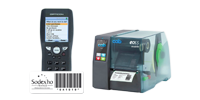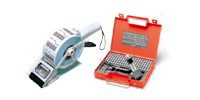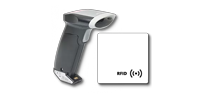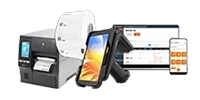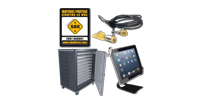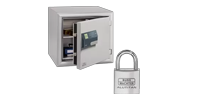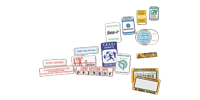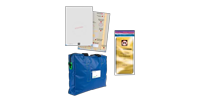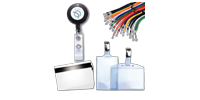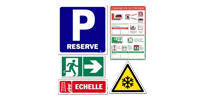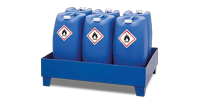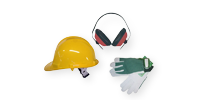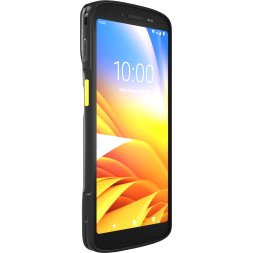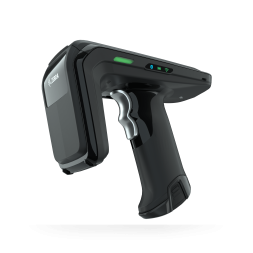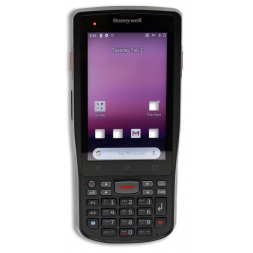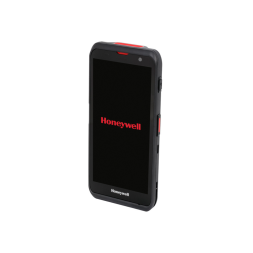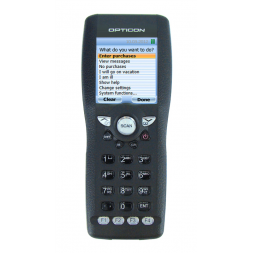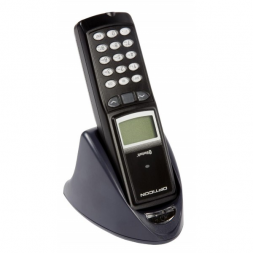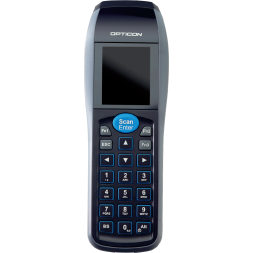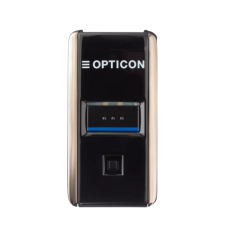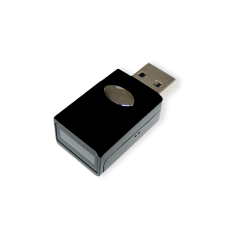What is a mobile terminal and what is it used for?
The barcode terminal (such as the Zebra TC22/TC27, the EDA51K or the OPH 1005) is a real asset for managing your inventories, receiving products, transporting goods and/or preparing orders. It will be your ally for efficiently collecting information from your stock or asset inventory. These models, just like the EDA52, the OPL 9815 or the PX-20, are rugged professional smartphones offering advanced data collection and real-time wireless communication features. They are used for mobile applications ranging from delivery and commercial or technical route management to customer support or retail sales.
Unlike barcode scanners, terminals such as the OPN 2500 terminal or the Scan Mini USB key are wireless, have a screen (or not, depending on the model) and generally come with an operating system such as Windows or Android. It is possible to have an RFID reader on request, for example with the Zebra RFD40, thanks to the addition of a cradle. To understand RFID, see our article on the subject.
Data collection is easier with these barcode readers. Indeed, models such as the OPH 3001 or the OPL 9815 have large memory capacity, allowing you to download the information later or send it directly via Bluetooth (depending on the distance from the cradle).
What is the difference between a mobile terminal and a smartphone?
The difference between a mobile terminal and a smartphone lies mainly in their functionalities and specific designs. They can both read codes, but the PDA is more adaptable than a smartphone.
A mobile terminal such as the EDA51K, the Zebra TC22/TC27 or the OPN 2500 terminal is a specialized device designed for specific tasks such as data collection, stock management, barcode reading, or inventory management. They feature rugged characteristics and advanced features suitable for professional environments.
In contrast, a smartphone is a versatile device designed to meet a wide range of needs, such as phone calls, messaging, internet browsing, social media, entertainment apps, etc. Smartphones are more geared toward personal use and are mostly used in daily life.
Although smartphones can perform some of the tasks carried out by mobile terminals, the latter offer more specialized functionalities, greater durability, better battery life, and higher resistance to harsh working conditions.
In summary, mobile terminals such as the OPH 1005, the EDA52 or the PX-20 are professional devices specially designed for specific tasks, while smartphones are multipurpose and intended for more general use.
Our range of standalone mobile terminals, from the most practical to the most complete
There are two types of mobile terminals:
- Simple and practical mobile terminals for quick and smooth use, such as the PX-20, the OPN 2500 terminal or the Scan Mini USB key.
- Barcode readers as powerful as a handheld computer, such as the EDA51K, the OPH 1005 or the Zebra TC22/TC27.
These PDAs (Personal Digital Assistant) such as the OPL 9815 or the OPH 3001 are extremely rugged smartphones that can store a large amount of data. They connect directly to your PC or Mac via USB cable or network, saving you considerable time during your identification and classification operations. With several hours of autonomy, you can record your data whenever you wish.
These Bluetooth barcode terminals are robust and durable, resistant to moisture, dust, and drops from heights of up to 2 m for most of them. Each mobile terminal presented, whether it is the Zebra RFD40, the OPN 2001 terminal or the PX-20, comes complete with its cradle or charging cable and wrist strap.
Here is a comparison table of our different mobile terminals:
| Terminal | Cradle/Cable | Battery life | Weight | Dimensions | Speed | Scan engine | Reading distance |
|---|
| ZEBRA TC22/TC27 | No USB-C cable or cradle provided | Up to 8 hours (depending on use) | 236 g | 16.5 cm x 7.63 cm x 1.25 cm | Not disclosed | 1D–2D + RFID (NFC/UHF) | From 0 to 60 cm (SE4710) / Up to 12 m (SE55 – depending on the barcode) |
|---|
| ZEBRA RFD40 | No USB-C cable or cradle provided | 18 hours | 541 g | 15.1 x 8.4 x 16.65 cm | 1,300 RFID tags/s | UHF RFID only | Up to 6 meters |
|---|
| EDA51K | USB cable included, cradle optional | 12 hours | 300 g | 164 x 73 x 24.5 mm | 104 scans/s | 1D–2D imager | 5 to 33 cm |
|---|
| EDA52 | Cradle or cable | 12 hours | 258 g | 159 mm x 75 mm x 14.4 mm (6.26 in x 2.95 in x 0.57 in) | 100 scans/s | 1D–2D and NFC | 6 to 30 cm |
|---|
| OPH 1005 | Cradle and cable included | 40 hours | 140 g | 55 x 136 x 23 mm | 100 scans/s | 1D Laser | 12 cm |
|---|
| OPL 9815 | Cradle and cable included | 50 hours | 115 g | 44 x 140 x 22 mm | 100 scans/s | 1D–2D imager | 3 to 30 cm |
|---|
| OPH 3001 | USB cable included, cradle optional | 40 hours | 156 g | 58.2 x 180.8 x 23.8 mm | 100 scans/s | 1D–2D imager | 20 cm |
|---|
| PX-20 | USB cable and wrist strap included | 35 hours | 40 g | 34 x 71 x 15 mm | 100 scans/s | 1D Laser | 20 cm |
|---|
| OPN 2001 terminal | USB cable included, cradle optional | 12 hours | 29 g | 32 x 62 x 16 mm | 100 scans/s | 1D–2D imager | 20 cm |
|---|
| Scan Mini USB key | (Bluetooth or wired) – USB cable and wrist strap | 8 hours | 150 g | 42 x 18 x 13 mm | 240 scans/sec | 1D CCD | 6 cm |
|---|
How to choose the right mobile terminal for reading barcodes?
There are a few questions to ask before choosing your handheld terminal—whether it’s a Zebra TC22/TC27, an EDA51K, an OPH 1005 or a PX-20—as well as its specifications:
- In what work environment will the barcode scanner be used? (factory, field work, store, etc.) For example, an OPL 9815 or an OPH 3001 is perfectly suited for extended mobile use.
- What user interface is preferred: with or without screen; numeric or alphanumeric keypad; wired or wireless? Some models like the EDA52 or the OPN 2500 terminal offer several configurations.
- How will data be transferred? (wired, Wi-Fi, WLAN, Bluetooth…) A terminal like the Scan Mini USB key or the PX-20 favors a fast Bluetooth connection, while a Zebra RFD40 also enables RFID usage.
- What type of barcodes must it read (1D or 2D) and at what distance? For example, the Zebra TC22/TC27 covers a wide reading range, while the OPL 9815 is optimized for short distances.
- Which operating system best fits your company (Android PDA, Windows CE or Mobile)? Models like the EDA51K and the EDA52 run on Android, while others favor a proprietary OS for simplified use.
These questions are essential so we can advise you on the right product for your needs.
The different connection types for your connected PDA
Terminals and PDAs—whether the Zebra TC22/TC27, the OPH 1005 or the PX-20—offer a variety of connection methods to communicate with other devices (printers, cash registers, etc.) and networks. Here are the main connection types:
- Wi-Fi: terminals like the EDA52 or the OPN 2500 terminal connect to wireless networks and access the Internet.
- Bluetooth: Bluetooth connectivity, available on the Scan Mini USB key or the PX-20, allows wireless pairing with printers, barcode readers, or computers.
- 4G/5G: certain models like the Zebra TC22/TC27 can be equipped with 4G/5G to access the Internet and communicate with other devices or mobile networks.
- USB: terminals such as the OPH 3001 or the OPL 9815 feature USB ports to connect to computers or other USB peripherals.
Think carefully about how you intend to use your PDA so it ticks all the boxes for your needs.

